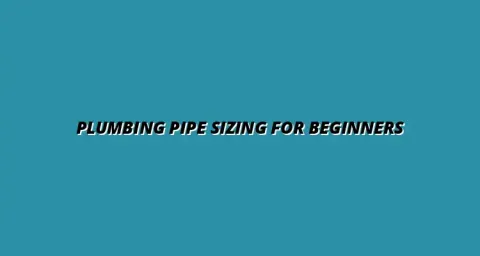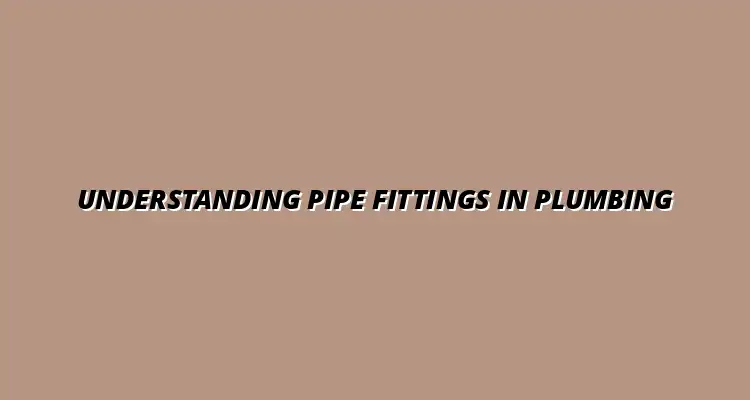
- Plumbing Basics
- Jan 15
2025-01-10
When it comes to plumbing systems, pipe fittings play a crucial role in connecting various components. They help ensure that water flows smoothly through pipes and that waste is directed away effectively. Understanding pipe fittings is essential for any homeowner or plumbing professional looking to tackle plumbing projects successfully! For a more in-depth look at plumbing systems, check out this helpful guide: Plumbing Systems Explained for Beginners.
With a variety of types and materials available, knowing how to choose the right type of pipe fitting can save time, money, and a lot of headaches down the road. Let's dive deeper into what pipe fittings are and the different types commonly used in plumbing!
Pipe fittings are components used in plumbing systems to connect pieces of pipe. They help to change the direction of water flow, modify the size of pipes, or even shut off the flow altogether. Understanding these functions is key to effective plumbing!
Without pipe fittings, water distribution would be inefficient and chaotic. They act as the connecting pieces that keep everything in place and functioning correctly. Every time you turn on a faucet or flush a toilet, you can thank these small but mighty components!
Each type of fitting has its specific use, making it important to choose the right one for your plumbing task. By combining these fittings effectively, you can create a well-functioning plumbing system that meets your needs!
Pipe fittings can be made from various materials, with the two most common being metal and plastic. Metal fittings, such as copper and brass, are known for their durability and strength. They are often used in high-pressure applications, making them a popular choice for many plumbing projects. Sometimes, despite your best efforts, issues arise. If you're dealing with a leaky kitchen sink, this guide can help: Repairing a Leaky Kitchen Sink.
On the other hand, plastic fittings, like PVC and CPVC, are lightweight and resistant to corrosion. They are typically easier to install and can be a cost-effective option for many plumbing applications. Each material has its advantages, which is why it’s important to consider your specific plumbing needs when making a choice!
By weighing these factors, you can select the best material for your plumbing system. Whether you prefer the strength of metal or the versatility of plastic, understanding the options available will help you make an informed decision!
When working with pipe fittings, safety should always be your top priority! Understanding the necessary precautions can help prevent accidents and injuries. By being aware of the possible hazards, you can ensure a safer working environment. If you're tackling a more complex project, consider the essential tools for bathroom repairs to ensure you're well-equipped: Essential Tools for Bathroom Repairs.
Before starting any plumbing project, it’s crucial to wear the right protective gear. This includes items like gloves, safety glasses, and masks. Using safety gear will help protect you from sharp edges, chemical exposure, and other potential dangers.
While installing pipe fittings, it’s essential to be aware of various hazards you might encounter. For instance, slippery surfaces and heavy materials can pose risks to your safety. Recognizing these hazards helps you take the necessary steps to mitigate them. Understanding plumbing vent systems is also crucial for proper ventilation and to avoid potential issues: Understanding Plumbing Vent Systems.
Some common hazards include:
The field of plumbing is witnessing exciting advancements in pipe fitting technology! These innovations not only improve functionality but also enhance the overall efficiency of plumbing systems. Staying updated on new designs and materials can be beneficial for both professionals and DIY enthusiasts. Troubleshooting gas water heater ignition problems can be challenging, but this guide can help: Gas Water Heater Ignition Issues.
Some notable trends include:
Sustainability is becoming increasingly important in plumbing practices. Many manufacturers are focusing on eco-friendly materials that reduce environmental impact. This shift not only helps the planet but can also lead to cost savings over time!
Some examples of sustainable practices include:
With technology evolving, smart plumbing innovations are making their way into our homes! These systems often use sensors and IoT devices to monitor and control water usage, enhancing plumbing efficiency. A clogged toilet can be a real headache, but this guide provides step-by-step instructions on how to fix it: Fixing a Clogged Toilet Guide.
Some examples of smart innovations include:
Pipe fittings are a critical element in the plumbing system, playing a vital role in both functionality and efficiency. By understanding their application and maintenance, homeowners and professionals alike can ensure their plumbing systems run smoothly. Quality fittings make a significant difference in the performance of plumbing systems! If you need professional help in Birmingham, consider contacting a plumber in Billesley, Birmingham.
Using high-quality pipe fittings can lead to a noticeable improvement in plumbing efficiency. Quality materials and precise fittings reduce leaks and pressure drops, which can save water and energy. This not only benefits the environment but can also lead to lower utility bills!
It’s essential for homeowners to have a good understanding of pipe fittings and their maintenance needs. Regular checks can help identify potential issues before they become significant problems. Taking the time to learn about pipe fittings will ensure a more effective plumbing system over the long term.
In conclusion, pipe fittings are indispensable in constructing and maintaining an effective plumbing system. By prioritizing safety, staying informed about new technologies, and understanding the importance of quality, everyone can contribute to a more efficient plumbing experience!
